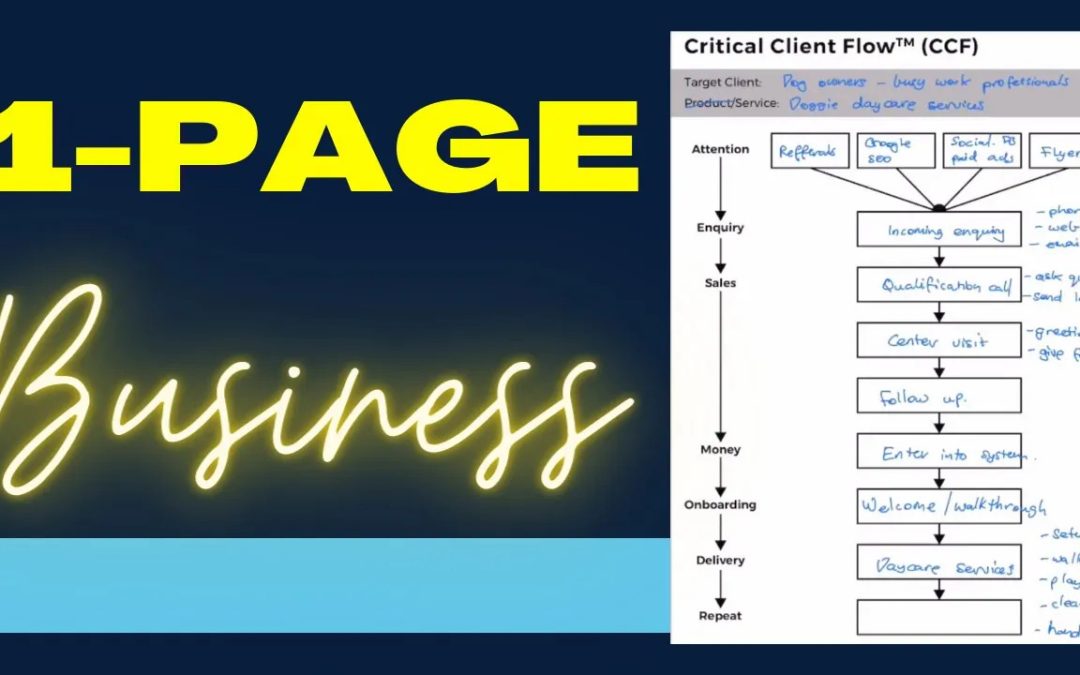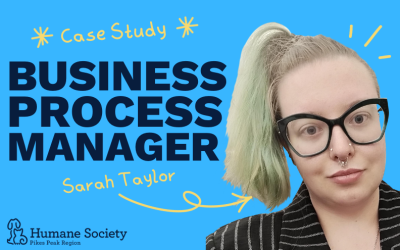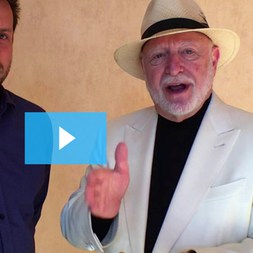Can you explain what your business does on one page?
The first step in systemisation is deciding which systems to create first. And to do that, you need to see an overview of your business’s core functions without any extra detail.
The trick is capturing the high level of the business’s flow in delivering your core product or service. You want to be able to see your business in terms of how your business:
➡️ Attracts customers
➡️ Handles enquiries
➡️ Processes Sales
➡️ Onboards clients
➡️ Delivery
➡️ Invoicing
Whilst it’s tempting to go into a lot of detail, you’ll get confused if you go too hard too soon. So keep it simple and save the finer details until later. We have a tool for this called the Critical Client Flow or CCF.
In this video, David Jenyns shows you how to distill what your business does down to one page so you can identify your critical systems.
Timestamps:
0:10 – How should you be thinking about systems
0:30 – What you should do first before systemising your business
0:47 – Introducing the Critical Client Flow
01:35 – An example of the Critical Client Flow
2:40 – Identifying complex business systems
03:40 – Other things to consider when systemising
4:25 – Defining the step or process
05:00 – The importance of the onboarding process
5:49 – Underpromise and overdeliver
06:00 – Grab your copy of SYSTEMology today
Transcription:
Hello, it’s David Jenyns, founder of SYSTEMology and in this video, I wanted to answer the question. As you’re populating the critical client flow, which is the first stage in SYSTEMology, how should you be thinking about breaking up the systems and how you describe and display them on the critical client flow, especially when there is maybe a detailed process that has lots of subsystems? And what considerations might you think about when doing the critical client flow first?
Now, if you don’t know what the heck I’m talking about, the first thing you need to do is grab yourself a copy of Systemology. It’s the system to systemize your business.
Step number one is to find out, well, which systems should you be creating first? And to do that, we have a tool we call the critical client flow. That’s what you can see on the screen here. And the question is how much detail should we be putting into this critical client flow? And particularly the boxes? Because some of the boxes might have detailed subsystems and processes, and obviously, capturing it in the box at just a very high level doesn’t give all of that extra detail.
So fortunately, later on in the SYSTEMology process, all of the detail comes out later when we start to think about the systems assigned sheet and we’re defining what are the systems we’re going to be capturing. But prior to that and the critical client flow, the purpose here is to capture at a high level the flow that the business goes through to deliver the core product or service, everything from grabbing someone’s attention to selling them through to delivery and then getting them to come back.
So let’s have a look at this example. We’ve got the business. It’s a doggy daycare center, and its target audience is busy work professionals that are dog owners. And the service is that doggy daycare services.
Now, some of these boxes, when we think about the different stages in the critical client flow, will be easier and more obvious to you than others. So, for example, if we’re going to say a lot of the business, for example, business comes from referrals, well, that fits nicely into the box.
But when we move down to something like an incoming inquiry, then, hey, the inquiry might come in via a phone, or maybe it’s a website form, or maybe it’s from an email that gets sent in. So they’re actually multiple different ways that it might be coming in. Now, does that mean we should be listing them as three separate systems or listed on the critical client flow? We’ve just got it as the incoming inquiry.
Similarly, if we move a little bit further down, oftentimes we see this a lot in delivery. So down here, delivery is usually one of the most complex parts where you’re going to have lots of subsystems. Maybe the daycare services might be some sort of overview system, but then we’ve got the setup and the walk and the play and the clean and the handover and all of these things which might be subsystems.
Again, all of that isn’t captured on the critical client flow because that happens a little bit later and we’ll start to introduce some ideas like the overview systems.
So when you’re completing the critical client flow at a very high level, you want someone to be able to read this who may not be in the business, even just at arm’s reach from the business and still be able to follow along and understand what’s going on. By design, the boxes have been kept small so you can only fit a few words in each. That’s part of the magic of being able to distill down into one page what it is that your business does.
And then by capturing this critical client flow, it becomes a fantastic place to get started. Now, just a couple of other considerations to think about when you’re wondering hey should I be breaking this into a new box or separate? One thing that I’ll think about is who is completing the task. If one person is completing these tasks and there are multiple steps, typically it’ll only end up being one box.
For example, there’s a good chance the person handling the incoming inquiry might be the front receptionist and they’re handling any of those incoming inquiries. They’re qualifying them, and then they’re connecting them with the appropriate team member who can then kind of explore things a little bit further.
So because it’s handled by one person, I’ll pop it in one box. Also, other ways that you might break it up is thinking about whether this is a distinct separate step or process like the incoming of the inquiry is one thing. The qualification might be a very separate thing because it’s separate. Let’s really tease that apart and have that as a separate step. And you can kind of see if we go from incoming inquiry qualification call to visiting the center, following up after they’ve visited the center, when they’re ready to go, getting them entered into the system as you can kind of see these distinct steps similarly down here.
One step that I always like to tease out also is the onboarding process. That’s the step where someone is getting started. They made a decision to work with your business and we want to make sure that we collect everything that we need from the client so we can deliver a great product or service for them.
We also might need to enter them into our project management platform and we need to set up appropriate folders and set expectations for clients. All of that setup, which I’m separating out, is different from the actual delivery of the product or service. I have that as a separate step because oftentimes that’s one that you really want to make sure that you nail because if you get that right, you can far exceed what the client is expecting and overdeliver for them. It’s a classic case. We love to under-promise and over-deliver and by setting the right expectations, you’re helping them to understand what is going to be happening.
So that’s a little bit about some of the thinking there might be some more nuance to it. You can obviously find out more by checking out the SYSTEMology book. If you have any more questions as well, just reach out to the team and me but hopefully, that was helpful in understanding a little bit more about the critical client flow and how you might be thinking about saving or laying it out and separating out those steps for your business.










